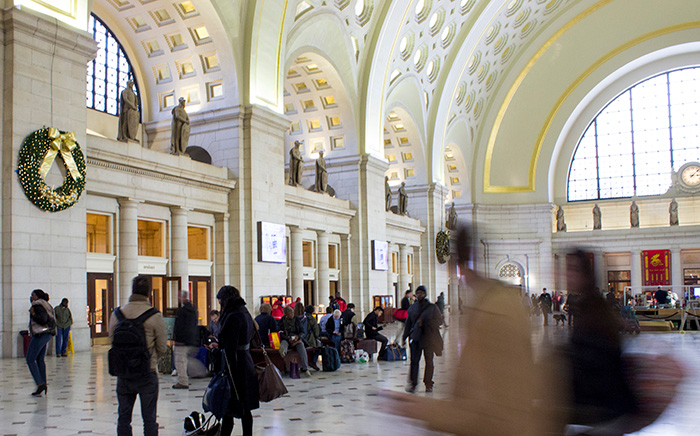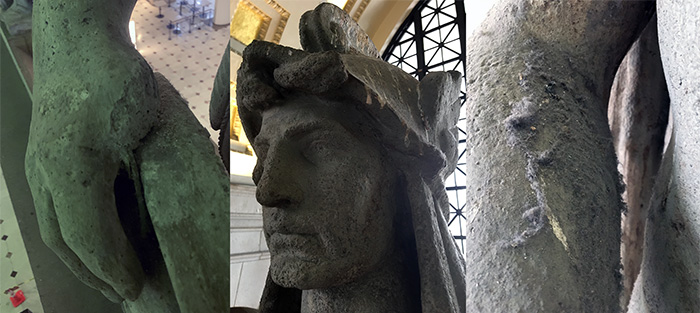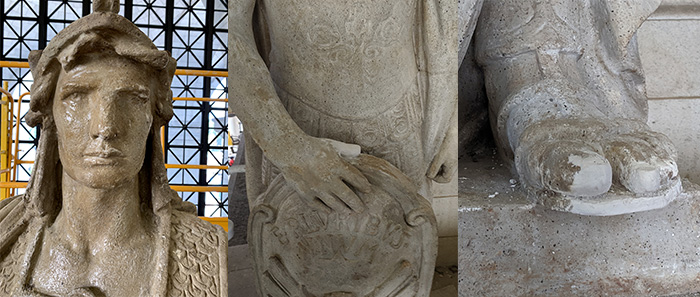
WASHINGTON, D.C. – For more than a century, visitors to Washington Union Station have passed beneath the watchful gaze of 36 Roman legionnaire statues perched around the impressive Main Hall, known for its barrel-vaulted ceiling with gilded coffers. The cast plaster statues, depicting legionnaires in various poses with eagle-adorned shields, tunics, capes and helmets, were designed by Louis Saint-Gaudens and installed in 1912. They had not been comprehensively cleaned and inspected since the station underwent a multi-year, $160 million restoration in the mid-1980s. Over the following three decades, they were subject to accumulations of dust and bird droppings and fluctuations in temperature and humidity.
Architectural restoration contractor John Canning & Co. of Cheshire, Conn., was chosen by the Union Station Redevelopment Corporation (USRC) to restore the statues and vestibules. The USRC, a non-profit organization that manages Union Station, was created in 1983 to preserve and restore the station’s historic and architectural significance, preserve its long-term function as a multi-use transportation center and enhance retail and amenities.

From August to November 2019, skilled restoration specialists undertook an initial treatment assessment and report for each statue to assess damage. Restoration work included cleaning the surfaces with a conservation cleaning agent, followed by plaster repairs and infilling, and inpainting to match the existing patina. According to the USRC, the project was partially funded by a Transportation Alternatives Program grant administered by the District Department of Transportation (DDOT). The soldiers now stand ready to greet another generation of travelers as the station prepares for a series of major infrastructure enhancements.
It was exciting to be a part of the team that worked to revive the history and restore the integrity of the legionnaires at Washington Union Station, a building that plays such a central role in the Washington, D.C., community.
Kara Waznis, Director of Projects, John Canning & Co.
“It has been an honor to apply our crafts at one of America’s civic architectural treasures. When working in the Main Hall balcony, we were witness to seeing thousands walk through the Grand Foyer of Washington, D.C.,” said John Canning & Co. Principal David Riccio. “For many, it is their first sight when arriving into the heart of our democracy. What a space, what a welcoming place.”
“The statues that guard the interior of Union Station are cast plaster treated with a unique method to imitate the surrounding stone. As a craftsman myself, it was a real honor to have a hand in the conservation of Louis Saint-Gaudens’ Roman legionnaires,” added Project Manager David Gough.

Completed in 1908, Union Station inspires visitors with its exquisitely detailed neoclassical architecture even though its bones are modern concrete and steel. More than 100,000 visitors pass through the building each day, including passengers using Amtrak, Maryland Area Regional Commuter (MARC) rail and Virginia Railway Express (VRE), Metro subway trains and buses, taxis, tourist buses, intercity buses and Capital Bikeshare. The building is also a popular shopping and dining destination for residents of the surrounding Capitol Hill neighborhood and the city at large.
Amtrak, in coordination with the USRC, WMATA, DDOT, Maryland Transit Administration/MARC, VRE and Federal Railroad Administration, is currently pursuing the Passenger Concourse Modernization Project. It’s the first set of improvements to come to life as part of the Washington Union Station 2nd Century Plan, a comprehensive initiative that seeks to triple passenger capacity and double train capacity over the next 20 years.
The Claytor Concourse serving Amtrak and commuter customers, located north of the Main Hall, will be reconfigured and modernized to double its capacity. The project will help alleviate congested conditions and enhance passenger comfort and accessibility, while enlivening the space with new architectural finishes and natural light. Among the amenities planned are new restrooms, accessibility for customers with disabilities, a new and expanded Metropolitan Lounge (formerly ClubAcela), and additional seating options with electrical outlets for travelers as they wait for their connections. Passenger boarding gates will be realigned for an improved boarding experience.
Posted March 4, 2020


 Amtrak established the Great American Stations Project in 2006 to educate communities on the benefits of redeveloping train stations, offer tools to community leaders to preserve their stations, and provide the appropriate Amtrak resources.
Amtrak established the Great American Stations Project in 2006 to educate communities on the benefits of redeveloping train stations, offer tools to community leaders to preserve their stations, and provide the appropriate Amtrak resources. For more than 50 years, Amtrak has connected America and modernized train travel. Offering a safe, environmentally efficient way to reach more than 500 destinations across 46 states and parts of Canada, Amtrak provides travelers with an experience that sets a new standard. Book travel, check train status, access your eTicket and more through the
For more than 50 years, Amtrak has connected America and modernized train travel. Offering a safe, environmentally efficient way to reach more than 500 destinations across 46 states and parts of Canada, Amtrak provides travelers with an experience that sets a new standard. Book travel, check train status, access your eTicket and more through the